rande77
Avid Member
AOL News (March 27) -- For some residents of the African island nation of Madagascar, encountering the tiny mammal called the aye-aye is as bad as meeting death itself.
The 4- to 6-pound animal is believed to creep into the houses of villagers and use its peculiarly long middle finger to lance the hearts of sleeping victims, according to Discovery News.
Natives of Madagascar often kill harmless aye-ayes over fears of what the animal represents.
For that reason, locals often kill the harmless animals on sight. Along with the loss of habitat caused by deforestation, superstition is a major reason the aye-aye is now considered to be at risk. Aye-aye population estimates range from 1,000 to 10,000.
Found only on Madagascar, aye-ayes are nocturnal primates that tend to live high in the trees of the rain forest, where they build nests of leaves and twigs. They use their long middle fingers to extract insect larvae from tree bark, according to National Geographic.
Some locals believe the legend that the appearance of an aye-aye -- which does not seem to fear the presence of human beings -- is a sign that a villager will soon die.
The animal, the largest nocturnal primate in the world, is now officially protected by law, but that often does not protect the aye-aye from residents convinced of its evil nature.
Children in the West, however, best know the aye-aye from the character Maurice in the animated "Madagascar" films.
Bob
The 4- to 6-pound animal is believed to creep into the houses of villagers and use its peculiarly long middle finger to lance the hearts of sleeping victims, according to Discovery News.
Natives of Madagascar often kill harmless aye-ayes over fears of what the animal represents.
For that reason, locals often kill the harmless animals on sight. Along with the loss of habitat caused by deforestation, superstition is a major reason the aye-aye is now considered to be at risk. Aye-aye population estimates range from 1,000 to 10,000.
Found only on Madagascar, aye-ayes are nocturnal primates that tend to live high in the trees of the rain forest, where they build nests of leaves and twigs. They use their long middle fingers to extract insect larvae from tree bark, according to National Geographic.
Some locals believe the legend that the appearance of an aye-aye -- which does not seem to fear the presence of human beings -- is a sign that a villager will soon die.
The animal, the largest nocturnal primate in the world, is now officially protected by law, but that often does not protect the aye-aye from residents convinced of its evil nature.
Children in the West, however, best know the aye-aye from the character Maurice in the animated "Madagascar" films.
Bob



